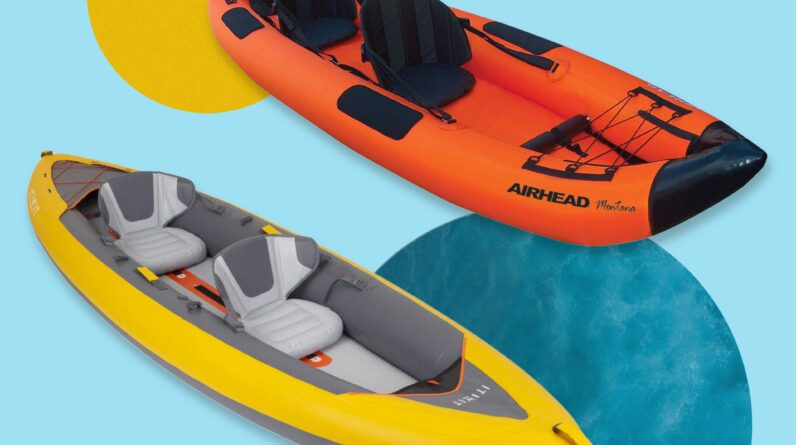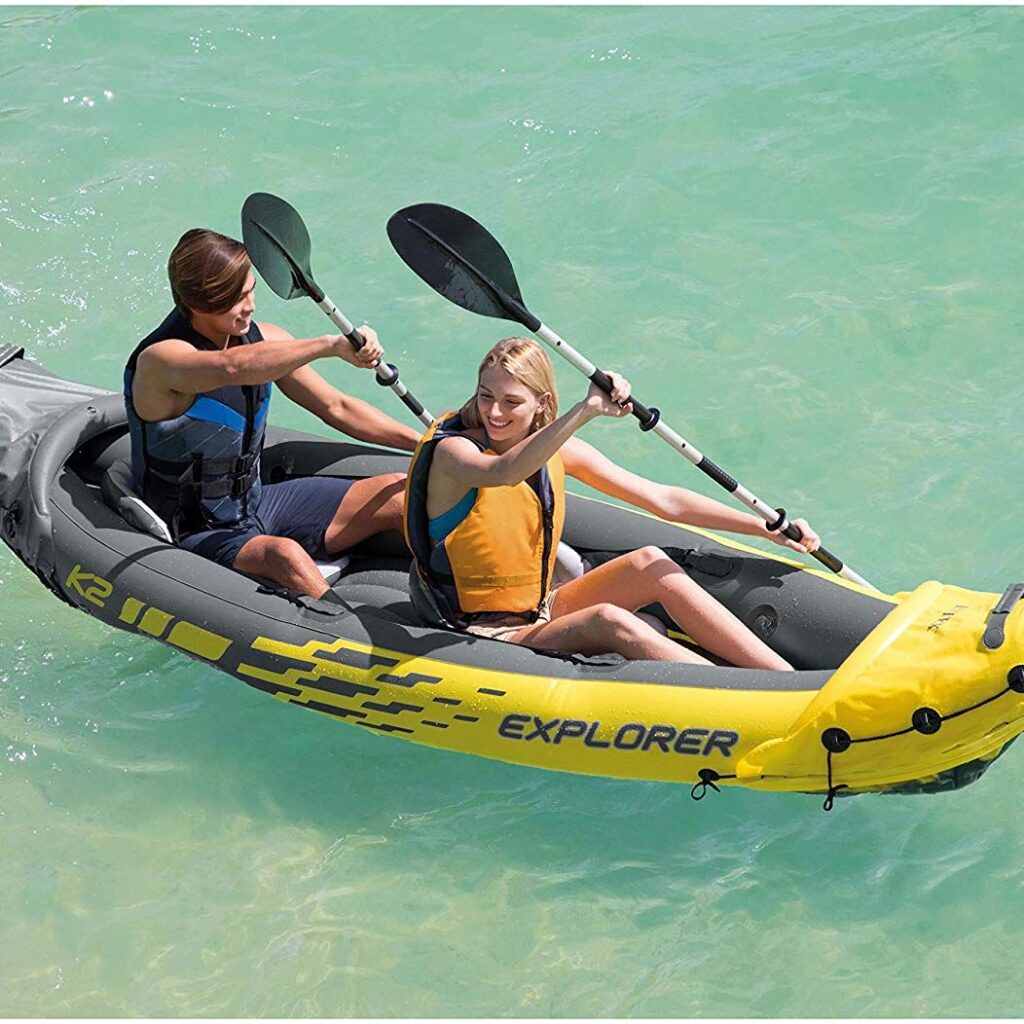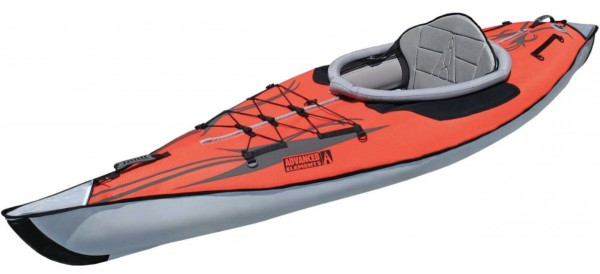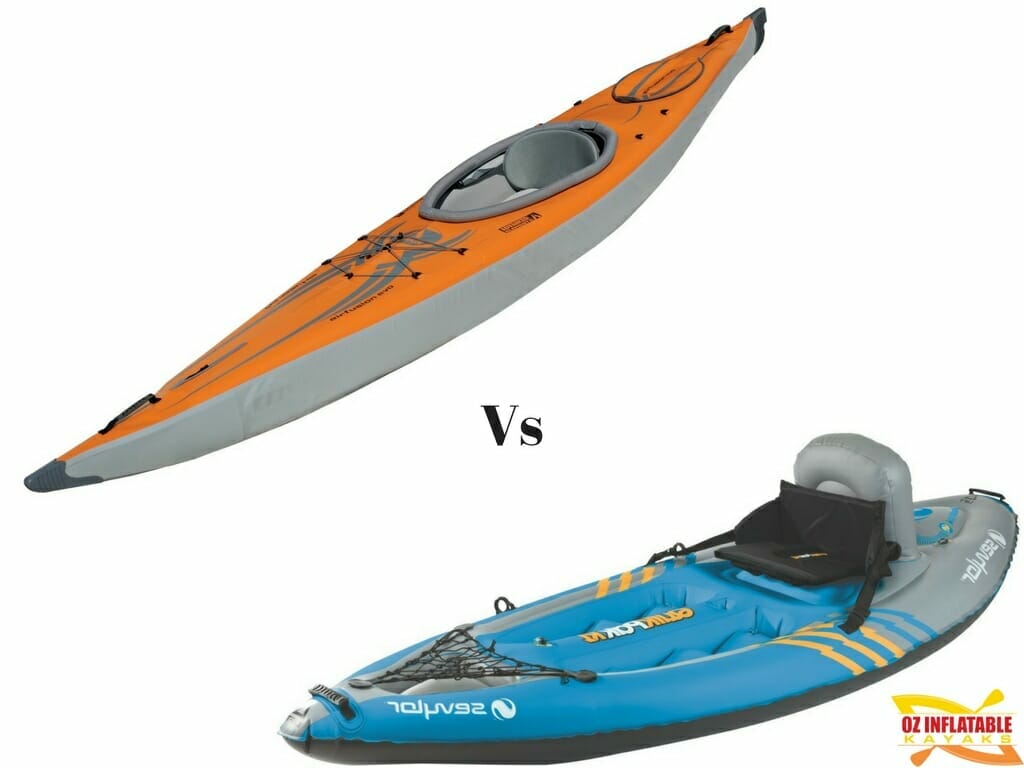
So, you’re thinking about getting a kayak, but you’re not quite sure if you should go for a traditional one or an inflatable one? Well, let’s chat about it for a moment. Have you ever considered the advantages of an inflatable kayak?
Let me tell you, inflatable kayaks have come a long way in recent years. Gone are the days of flimsy, unreliable vessels. Nowadays, they are made from durable materials that can withstand rough waters and rocky shores. Plus, they’re incredibly convenient. You can easily transport them in the trunk of your car or even carry them on your back when hiking to a remote lake.
But you may be wondering, do they perform as well as a traditional hard-shell kayak? Believe it or not, inflatable kayaks are designed to provide stability and maneuverability similar to their hard-shell counterparts. With advanced designs and enhanced stability features, you’ll be pleasantly surprised by how well they handle on the water. Whether you’re a beginner or an experienced paddler, inflatable kayaks can offer a fun and reliable experience.
In fact, inflatable kayaks are perfect for those who love exploring new waters. Their lightweight construction makes them easy to transport and set up in no time. And let’s not forget about storage! Unlike hard-shell kayaks that take up valuable garage space, inflatable kayaks can be easily deflated and stored in a compact bag. So, if you’re looking for a versatile and user-friendly option, inflatable kayaks may just be the perfect fit for you.
To learn more about the world of inflatable kayaks and discover the variety of options available, be sure to check out our upcoming article. We’ll dive deep into the pros and cons, discuss different models, and provide some helpful tips to consider when making your purchase. So stay tuned, and get ready to embark on your kayaking adventures with an inflatable kayak!

The Benefits of Inflatable Kayaks
In recent years, inflatable kayaks have gained popularity among outdoor enthusiasts, and for good reason. These portable and convenient watercraft offer a host of benefits that make them a smart choice for both beginners and experienced paddlers alike. In this article, we will explore the various advantages of inflatable kayaks and why they may be the perfect option for your next water adventure.
Portability and Convenience
One of the most significant advantages of inflatable kayaks is their unmatched portability and convenience. Unlike traditional hardshell kayaks, inflatables can be deflated and easily transported in a backpack or a storage bag. This makes them an ideal choice for those who want to explore different bodies of water without the hassle of transporting a heavy and bulky kayak.
Whether you’re planning a day trip to a nearby lake or embarking on a multi-day expedition, the compact size of inflatable kayaks allows for easy transportation and storage. You can simply pack it in your car trunk or carry it on public transportation without any fuss.
Durability and Strength
Contrary to popular belief, inflatable kayaks are made from highly durable materials that can withstand rugged conditions. Most modern inflatables are constructed using materials such as PVC or Hypalon, which are incredibly strong and resistant to punctures and tears.
Additionally, many inflatable kayaks feature reinforced hulls and multiple air chambers that provide added stability and buoyancy. Even if one chamber gets punctured, the remaining chambers will keep you afloat and allow you to safely return to shore.
Ease of Use and Versatility
Another significant advantage of inflatable kayaks is their user-friendly nature and versatility. Unlike traditional kayaks that require extensive knowledge and skills to navigate, inflatables are easy to handle and ideal for beginners.
The setup process for inflatable kayaks is incredibly straightforward. Most models come with a manual air pump that allows you to inflate the kayak within minutes. Some advanced inflatables even feature built-in electric pumps for added convenience.
Inflatable kayaks are also versatile in terms of the water conditions in which they can be used. Whether you prefer a calm paddle on a serene lake or an exhilarating adventure on a white-water river, there’s an inflatable kayak designed for every type of water activity.
The Different Types of Inflatable Kayaks
When it comes to inflatable kayaks, there are several different types to choose from, each catering to specific needs and preferences. Let’s take a closer look at the three main types of inflatable kayaks available on the market.
Recreational Inflatable Kayaks
Recreational inflatable kayaks are perfect for those who enjoy leisurely paddling and exploring calm waters such as lakes and slow-moving rivers. These kayaks are designed for stability and comfort, featuring wide and spacious cockpits that accommodate paddlers of all sizes.
Recreational inflatables are usually the most affordable option and are a great choice for beginners or families looking to enjoy a day on the water. They provide a smooth and relaxing paddling experience and are suitable for individuals who prioritize comfort over speed.
Touring Inflatable Kayaks
If you’re planning a longer journey or overnight camping trip, a touring inflatable kayak might be the perfect choice for you. These kayaks offer enhanced tracking and speed compared to recreational models, allowing you to cover larger distances with ease.
Touring inflatables typically have a sleeker design and longer waterline, providing better efficiency and performance. They often feature additional storage compartments and deck rigging systems, allowing you to carry camping gear, food, and other essential items for extended trips.
White Water Inflatable Kayaks
For adrenaline junkies and thrill-seekers, white water inflatable kayaks are an exciting option. These kayaks are specifically designed to handle the challenges of fast-flowing rivers and turbulent rapids.
White water inflatables feature more pronounced rocker profiles and increased maneuverability, enabling you to navigate through tight turns and obstacles with precision. They also come with reinforced materials and additional protection to withstand the rough conditions of white water kayaking.
Things to Consider Before Buying an Inflatable Kayak
Before making a purchase, it’s essential to consider a few factors to ensure you choose the right inflatable kayak for your specific needs. Here are three key considerations to keep in mind.
Weight Capacity
The weight capacity of an inflatable kayak is an important consideration, as it determines how much gear and weight the kayak can handle without compromising stability and performance. Make sure to choose a kayak with a weight capacity that accommodates your body weight and any additional items you plan on carrying, such as camping gear or fishing equipment.
Storage Space
Depending on your intended use, the storage space offered by an inflatable kayak can vary significantly. If you plan on embarking on multi-day trips or need to carry a significant amount of gear, look for a kayak with ample storage compartments and lash points for securing your belongings.
On the other hand, if you primarily plan on using the kayak for short day trips, a more streamlined and compact model with minimal storage may be sufficient.
Pump and Accessories
While most inflatable kayaks come with a manual air pump, it’s worth considering the ease of inflation and deflation when choosing a model. Some kayaks offer the convenience of built-in electric pumps or high-pressure systems that make inflation a breeze.
Additionally, consider the included accessories such as paddles, seats, and repair kits. Investing in a kayak that comes with high-quality accessories can save you time and money in the long run.
Tips for Using an Inflatable Kayak Safely
While inflatable kayaks are generally safe and easy to use, it’s important to follow certain safety guidelines to ensure a positive and secure paddling experience. Here are three essential safety tips to keep in mind when using an inflatable kayak.
Wear a Life Jacket
Regardless of your swimming abilities or the calmness of the water, always wear a properly fitted life jacket when kayaking. Inflatable kayaks provide buoyancy, but a life jacket adds an extra layer of safety and ensures you stay afloat in case of an accident or capsizing.
Choose a life jacket that is approved by the relevant authorities and fits you snugly without restricting your movement.
Be Aware of Weather Conditions
Before heading out on the water, it’s crucial to check the weather forecast and be aware of any potential changes in conditions. Kayaking in adverse weather can be dangerous, so avoid paddling during storms, heavy winds, or thunderstorms.
Additionally, be mindful of changes in weather patterns while you’re on the water. Sudden changes in wind or temperature can impact your ability to paddle and navigate, so stay vigilant and make sure to seek shelter if necessary.
Inspect Your Kayak Regularly
Before each outing, thoroughly inspect your inflatable kayak for any signs of damage or wear and tear. Check for leaks, punctures, or loose valves, and make sure all seams and attachments are secure.
Regularly cleaning your kayak and drying it thoroughly after each use will help prevent damage and ensure it remains in optimal condition. Avoid storing your kayak in direct sunlight or extreme temperatures, as this can weaken the materials and decrease its lifespan.

Maintaining and Repairing Inflatable Kayaks
Despite their durability, inflatable kayaks may occasionally require maintenance and repairs. Knowing how to properly clean, repair, and store your kayak will help prolong its lifespan and ensure it remains in excellent condition. Here are some essential maintenance tips to keep in mind.
Cleaning and Drying
After each use, rinse your inflatable kayak with fresh water to remove any dirt, sand, or saltwater residue. Use a mild detergent if necessary, but avoid using harsh chemicals or abrasive materials that could damage the kayak’s surface.
Once clean, make sure to dry the kayak thoroughly before storing it. It’s crucial to prevent moisture from getting trapped inside, as this can lead to mold or mildew growth.
Repairing Punctures or Tears
In the unfortunate event that your inflatable kayak sustains a puncture or tear, it’s important to address the issue promptly to prevent further damage. Most inflatable kayaks come with a repair kit that includes adhesive patches and instructions for patching small holes.
For larger tears or more significant damage, it’s recommended to seek professional repair services or consult the manufacturer for guidance. Attempting to repair extensive damage without the necessary expertise may compromise the kayak’s integrity and safety.
Storing Properly
Proper storage is crucial for maintaining the longevity and performance of your inflatable kayak. Store the kayak in a cool, dry place away from direct sunlight and extreme temperatures. Excessive heat or cold can deteriorate the kayak’s materials or cause them to become brittle.
If possible, store the kayak in a protective bag or case to prevent exposure to dust, debris, and potential damage from other objects. Make sure to deflate the kayak fully and fold it carefully to avoid unnecessary stress on the materials.
Inflatable Kayaks vs. Hardshell Kayaks
While inflatable kayaks offer a range of advantages, it’s important to consider the pros and cons when comparing them to traditional hardshell kayaks. Each type of kayak has its own unique features and considerations. Let’s examine the key differences between inflatable and hardshell kayaks.
Pros and Cons of Inflatable Kayaks
Inflatable kayaks are known for their portability, ease of use, and versatility. They are incredibly convenient to transport and store, making them suitable for those with limited space or frequent travelers.
Additionally, inflatables are generally more affordable than hardshell kayaks, making them a great option for budget-conscious paddlers. They also tend to be more stable, which is especially beneficial for beginners or individuals who prefer a relaxed and comfortable paddling experience.
However, inflatable kayaks are not as fast or maneuverable as hardshell kayaks. They also require more effort to paddle due to their inflated nature, which may not be ideal for experienced kayakers or those looking for high-performance vessels.
Pros and Cons of Hardshell Kayaks
Hardshell kayaks, on the other hand, offer superior performance and speed compared to inflatable kayaks. Their rigid and streamlined design allows for increased efficiency and smoother gliding through the water.
Hardshell kayaks are also more durable and resistant to damage, as they are typically made from materials such as fiberglass or polyethylene. They are better suited for rougher waters and provide an enhanced sense of control and maneuverability.
However, hardshell kayaks are significantly bulkier and heavier compared to inflatables, making transportation and storage more challenging. They also tend to be more expensive, which may be a limiting factor for individuals on a tight budget.
Choosing the Right Kayak for You
When deciding between an inflatable kayak and a hardshell kayak, consider your specific needs, preferences, and intended use. If portability, convenience, and affordability are your top priorities, an inflatable kayak may be the perfect choice for you.
On the other hand, if speed, performance, and durability are essential factors for your water adventures, a hardshell kayak may be more suitable. It’s important to weigh the pros and cons of each type and choose the kayak that aligns with your preferences and requirements.

Popular Brands of Inflatable Kayaks
With the growing popularity of inflatable kayaks, numerous brands have emerged in the market, offering a wide range of options to choose from. Here are three popular brands known for their quality and performance.
Intex
Intex is a well-known brand that offers a diverse range of inflatable kayaks suitable for various water activities. Their kayaks are known for their durability, stability, and affordability. Intex inflatables are designed with user-friendly features and quality materials, making them a popular choice among recreational kayakers.
Advanced Elements
Advanced Elements is a brand that focuses on producing high-quality inflatable kayaks designed for performance and comfort. Their kayaks are known for their advanced technology, durability, and versatility. With features such as aluminum ribs and reinforced hulls, Advanced Elements inflatables provide excellent maneuverability and tracking.
Sea Eagle
Sea Eagle is a reputable brand that has been in the inflatable kayak industry for decades. They offer a wide range of kayaks suitable for different skill levels and water conditions. Sea Eagle inflatables are known for their durability, stability, and exceptional build quality. Their kayaks feature innovative designs and materials that ensure a secure and enjoyable paddling experience.
When choosing an inflatable kayak, it’s worth exploring different brands and models to find the one that best suits your needs and preferences. Research customer reviews and seek recommendations from experienced paddlers to ensure you select a reliable and high-quality kayak.
Best Places to Use an Inflatable Kayak
Once you’ve acquired your inflatable kayak, the next step is to discover the best places to enjoy it. Inflatable kayaks can be used in a variety of water environments, each offering unique experiences and challenges. Here are three popular types of water bodies where inflatable kayaks thrive.
Lakes and Reservoirs
Lakes and reservoirs provide tranquil and scenic settings for kayaking enthusiasts. These expansive bodies of water offer a relaxed environment for leisurely paddling and exploring nature. Whether you prefer a peaceful sunrise paddle or an afternoon adventure with friends and family, lakes and reservoirs are ideal destinations for inflatable kayaks.
Rivers and Streams
For those seeking a bit more excitement, rivers and streams provide opportunities for thrilling and adventurous kayaking experiences. Inflatable kayaks are particularly well-suited for navigating through shallow, fast-flowing waters, as they can maneuver easily around rocks and other obstacles.
However, it’s important to be mindful of the specific characteristics and difficulties of the river or stream you plan to explore. Always research the water conditions and potential hazards beforehand, and make sure your skill level aligns with the demands of the chosen waterway.
Coastlines and Oceans
If you’re fortunate enough to live near a coastline or have access to the ocean, inflatable kayaks can open up a whole new world of exploration. Coastal kayaking allows you to discover hidden coves, caves, and sandy beaches that are inaccessible by foot. It also provides an opportunity to observe marine life, such as dolphins, seals, and various bird species.
When kayaking in coastal or oceanic environments, it’s crucial to be aware of tidal currents, waves, and potential hazards such as strong winds or offshore undertows. Always check the weather forecast, wear appropriate safety gear, and paddle within your skill level.

Tips for Paddling in an Inflatable Kayak
To make the most of your inflatable kayak and ensure a fun and safe paddling experience, it’s important to follow proper paddling techniques and be mindful of certain key factors. Here are three essential tips to help you paddle confidently in your inflatable kayak.
Proper Paddling Technique
Mastering the correct paddling technique will enhance your efficiency and control in the water. Start by sitting comfortably with your back straight and your legs slightly bent. Hold the paddle with a grip that feels natural and allows for easy rotation of your torso.
When stroking, dip the blade of the paddle fully into the water while keeping your arms straight. Rotate your torso and engage your core muscles to generate power and propel yourself forward. Repeat the stroke on the opposite side to maintain a smooth and balanced paddling rhythm.
Navigating Obstacles
While inflatable kayaks are highly maneuverable, it’s important to approach obstacles and potential hazards with caution. Whether it’s rocks, fallen branches, or low-hanging trees, always survey the area ahead and plan your path accordingly.
If you need to maneuver around an obstacle, use quick and controlled strokes to turn your kayak. Practice tight turns and pivoting motions to develop your kayaking skills and ability to navigate challenging environments.
Using Proper Body Position
Proper body position is crucial for maintaining stability and balance in your inflatable kayak. Keep your weight centered and distribute it evenly across the kayak to prevent tipping or rolling. Avoid sudden movements or shifting your weight too dramatically, as this can disrupt the kayak’s stability.
Keep your legs slightly bent and your feet resting comfortably against the footrests or braces. This will provide additional support and enable you to use your lower body to help control the kayak’s movement.
Conclusion
Inflatable kayaks offer a multitude of benefits that make them an excellent choice for water enthusiasts of all levels. Their portability, durability, and ease of use make them an appealing option for those seeking convenience and versatility.
When choosing an inflatable kayak, consider factors such as weight capacity, storage space, and included accessories. Additionally, ensure you follow safety guidelines and maintain your kayak properly to ensure its longevity.
Whether you plan on paddling in lakes, rivers, or along coastal shorelines, inflatable kayaks provide endless opportunities for exploration and adventure. So, grab your paddle and embark on your next water journey with confidence in the quality and performance of your inflatable kayak.








